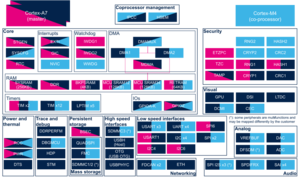1. Article purpose[edit | edit source]
The purpose of this article is to:
- briefly introduce the HSEM peripheral and its main features,
- indicate the peripheral instances assignment at boot time and their assignment at runtime (including whether instances can be allocated to secure contexts),
- list the software frameworks and drivers managing the peripheral,
- explain how to configure the peripheral.
2. Peripheral overview[edit | edit source]
The HSEM (hardware spinlock) peripheral is used to provide synchronization and mutual exclusion between heterogeneous processors.
- 32 hardware semaphores are available on the platform.
- semaphores could be accessed by the Arm® Cortex®-A7 core and the Arm® Cortex®-M4
Refer to the STM32MP15 reference manuals for the complete list of features, and to the software frameworks and drivers, introduced below, to see which features are implemented.
3. Peripheral usage[edit | edit source]
This chapter is applicable in the scope of the OpenSTLinux BSP running on the Arm® Cortex®-A processor(s), and the STM32CubeMPU Package running on the Arm® Cortex®-M processor.
3.1. Boot time assignment[edit | edit source]
3.1.1. On STM32MP15x lines  [edit | edit source]
[edit | edit source]
The hardware semaphore is used at boot time for GPIO access protection between the Arm® Cortex®-A7 and Cortex®-M4 cores. See Protecting GPIO and EXTI system resources by hardware semaphores for details.
Click on ![]() to expand or collapse the legend...
to expand or collapse the legend...
Check boxes illustrate the possible peripheral allocations supported by the OpenSTLinux BSP:
- ⬚ means that the peripheral can be assigned to the given boot time context, but this configuration is not supported in OpenSTLinux BSP.
- ☐ means that the peripheral can be assigned to the given boot time context.
- ☑ means that the peripheral is assigned by default to the given boot time context and that the peripheral is mandatory for the OpenSTLinux BSP.
- ✓ is used for system peripherals that cannot be unchecked because they are hardware connected in the device.
The present chapter describes STMicroelectronics recommendations or choice of implementation. Additional possibilities might be described in STM32 MPU reference manuals.
| Domain | Peripheral | Boot time allocation | Comment | |||
|---|---|---|---|---|---|---|
| Instance | Cortex-A7 secure (ROM code) |
Cortex-A7 secure (TF-A BL2) |
Cortex-A7 nonsecure (U-Boot) | |||
| Coprocessor | HSEM | HSEM | ☐ | |||
3.2. Runtime assignment[edit | edit source]
3.2.1. On STM32MP15x lines  [edit | edit source]
[edit | edit source]
It does not make sense to allocate HSEM to a single runtime execution context, that is why it is enabled by default for both cores in the STM32CubeMX.
The hardware semaphore is used at runtime for GPIO and EXTI access protection between the Arm® Cortex®-A7 and Cortex®-M4 cores. See Protecting GPIO and EXTI system resources by hardware semaphores for details.
Click on ![]() to expand or collapse the legend...
to expand or collapse the legend...
Check boxes illustrate the possible peripheral allocations supported by the OpenSTLinux BSP:
- ⬚ means that the peripheral can be assigned to the given runtime context, but this configuration is not supported in OpenSTLinux BSP.
- ☐ means that the peripheral can be assigned to the given runtime context.
- ☑ means that the peripheral is assigned by default to the given runtime context and that the peripheral is mandatory for the OpenSTLinux BSP.
- ✓ is used for system peripherals that cannot be unchecked because they are hardware connected in the device.
Refer to How to assign an internal peripheral to an execution context for more information on how to assign peripherals manually or via STM32CubeMX.
The present chapter describes STMicroelectronics recommendations or choice of implementation. Additional possiblities might be described in STM32MP15 reference manuals.
| Domain | Peripheral | Runtime allocation | Comment | |||
|---|---|---|---|---|---|---|
| Instance | Cortex-A7 secure (OP-TEE) |
Cortex-A7 nonsecure (Linux) |
Cortex-M4 (STM32Cube) | |||
| Coprocessor | HSEM | HSEM | ⬚ | ☑ | ☑ | |
4. Software frameworks and drivers[edit | edit source]
Below are listed the software frameworks and drivers managing the HSEM peripheral for the embedded software components listed in the above tables.
- Linux®: hardware spinlock framework
- STM32Cube: HSEM HAL driver and header file of HSEM HAL module
5. How to assign and configure the peripheral[edit | edit source]
The peripheral assignment can be done via the STM32CubeMX graphical tool (and manually completed if needed).
This tool also helps to configure the peripheral:
- partial device trees (pin control and clock tree) generation for the OpenSTLinux software components,
- HAL initialization code generation for the STM32CubeMPU Package.
The configuration is applied by the firmware running in the context in which the peripheral is assigned.
The HSEM peripheral is shared between the Cortex-A and Cortex-M contexts, so a particular attention must be paid to have a complementary configuration on both contexts.
